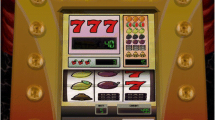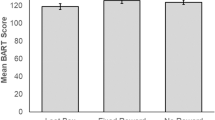Abstract
The purpose of the present study was to evaluate whether near wins can prolong gambling activity on a video lottery terminal. In a three-reel game, near wins were operationally defined as two identical symbols followed by a third different symbol. Players in an experimental condition were exposed to 27% near wins in a series of continuous losses, whereas players in a control group were exposed to none. Participants played as long as they wished, and received real money for their wins. The results showed that players in the near win condition played 33% more games than did the control group. The results of this study suggest that near wins can be added to the list of factors that may motivate people to gamble despite the probability of monetary loss.
Similar content being viewed by others
References
Amsel, A. (1992). Frustration theory: An analysis of dispositional learning and memory. Cambridge: Cambridge University Press.
Delfabbro, P. H., & Winefield, A. H. (1999). The danger of over-explanation in psychological research: a reply to Griffiths. British Journal of Psychology, 90, 447-450.
Griffiths, M. (1995). Adolescent gambling. London: Routledge.
Griffiths, M. D. (1999). The psychology of the near-miss (revisited): a comment on Delfabbro & Winefield (1999). British Journal of Psychology, 90, 441-445.
Ladouceur, R. & Walker, M. (1996). A cognitive perspective on gambling. In P.M. Salkovskis (Ed.), Trends in cognitive and behavioural therapies, pp. 89-120, Oxford: Wiley.
Langer, E. J. (1975). The illusion of control. Journal of Personality and Social Psychology, 32, 311-328.
Lesieur, H. R. & Blume, S. B. (1987). The South Oaks Gambling Screen (SOGS): A new instrument for the identification of pathological gamblers. American Journal of Psychiatry, 144, 1184-1188.
Reid, R. L. (1986). The psychology of the near miss. Journal of Gambling Behavior, 2, 32-39.
Skinner, B. F. (1953). Science and human behavior. New York: The Macmillan Company.
Strickland, L. H., & Grote, F. W. (1967). Temporal presentation of winning symbols and slotmachine playing. Journal of Experimental Psychology, 74, 10-13.
Walker, M. B. (1992). The psychology of gambling. Oxford: Pergamon Press.
Author information
Authors and Affiliations
Rights and permissions
About this article
Cite this article
Côté, D., Caron, A., Aubert, J. et al. Near Wins Prolong Gambling on a Video Lottery Terminal. J Gambl Stud 19, 433–438 (2003). https://doi.org/10.1023/A:1026384011003
Issue Date:
DOI: https://doi.org/10.1023/A:1026384011003




